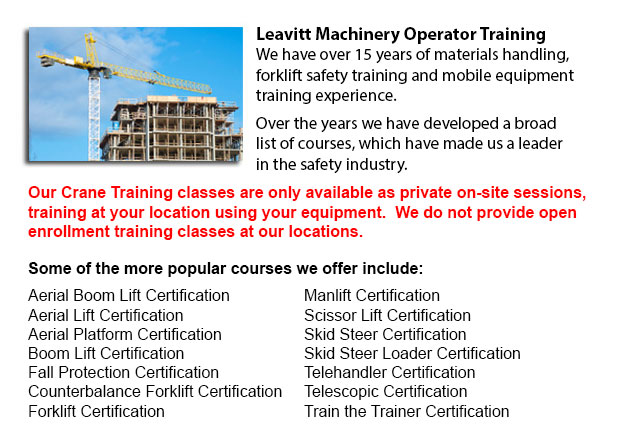
Kingston Crane Certification - The Crane Certification Program includes the industry suggested subject matter that would teach the safe and efficient operation of cranes. The person would train in the following: how to identify cranes and their component parts; pre-operational, operational and post-operating requirements; rigging components and inspection/rejection criteria; how to determine overall lift capacity; and needs specific to the work site where the people training will be operating.
The requirements which must be performed before operating a crane such as assigning authority for the pre-operational check; carrying out the sequential pre-operational check based on the manufacturer's specifications or specifications certified by a professional engineer; checking the log book for comments; checking the work place for obstacles and hazards; inspecting chains, cables, hooks safety latches and crane movement; making certain of the proper functioning of operational controls; and learning how to ensure the crane's disconnect switch/isolator is functioning correctly.
The requirements to operating a crane would consist of the identifying of responsibilities and roles, and the determination of the need for a formal lift plan. The person training will know how to do danger assessments for the different environmental circumstances, physical conditions and staff. Subject matter consists of determining when to seek competent aid, the destination of loads and the safest route, and centre of gravity and load weight.
It is essential for individuals training to be able to identify an over-capacity lift, select proper rigging equipment, know load restrictions, and determine a safe spot from which to operate. Trainees will review both site-specific and universal crane signals for lifts, and techniques for traveling, lifting and loading. Correct maintenance habits will be covered.
People training would be assessed on their understanding of the need for emergency response procedures for different situations like for example a mechanical or electrical failure. They would be asked to describe parking and shut down procedures for safety and security, to follow tagging and lock out techniques, and to explain the reason why near misses are reported and recorded to the right person. Log book records should be maintained.
The person training will be taught the particulars of rigging, and know the responsibility and authority for rigging. They would be taught to identify the different kinds of rigging, storage procedures and the load capacity ratings.
Post-operational requirements include entering defects or deficiencies, maintenance and service history in the log book, based on Federal, state and provincial codes requirements.
Site-specific needs could be incorporated into the safety training program according to the employer's needs.
-
Narrow Aisle Forklift / Order Picker Training / Electric Pallet Jack / Electric Pallet Truck Training in Kingston
A pallet lift is a piece of equipment dedicated in the moving of pallets of various dimensions and weights. They might be utilized as an accessory for forklifts, cranes and other styles of heavy machinery or be applied on their own. Pallet lifts are... More -
Kingston Forklift Training School
Kingston Forklift Training School - Forklift Training School - Industry and federal regulators have established the criteria for forklift safety training based on their existing regulations and standards. People wishing to operate a forklift must fin... More -
Kingston Scissor Lift Certification
Kingston Scissor Lift Certification - Scissor lift platforms are utilized at work locations to enable tradespeople - such as iron workers, welders and masons - to reach their work. Making use of a scissor lift platform is usually secondary to their t... More -
Kingston Boom Lift Safety Training
Kingston Boom Lift Safey Training - Boom lifts are a type of elevated work platform or aerial lifting device that are normally utilized in warehousing, construction and industry. Boom lifts could be made use of in practically whichever environment du... More -
Kingston Fall Protection Ticket
Kingston Fall Protection Ticket - Fall-related incidents are the number one reason of death in the construction business. The possibility for fall accidents very much increases based upon the type of work which is being accomplished within your workp... More -
Telehandler Training in Kingston
Telescopic handlers normally called telehandlers for short, are an extremely popular piece of heavy construction machinery. They are widely utilized in the construction and agricultural trades. These machines have farthest reaching ability and are ab... More -
Kingston Warehouse Forklift Training Programs
Kingston Warehouse Forklift Training Programs - Warehouses could either be retail, industrial or commercial facilities, functioning from bulk product retailing to product distribution services. Regardless of the type of warehouse, personnel inside wa... More -
Kingston Heavy Equipment Ticket
Kingston Heavy Equipment Ticket - Depending on the nature of the job at hand, the kind of construction machinery that a heavy equipment operator utilizes varies. Every type of equipment is built to do particular jobs in the most effective method comm... More

Forklift Certification Kingston
TOLL FREE: 1-888-254-6157
Kingston, Ontario
forkliftcertificationkingston.com
Email Us
About Us


